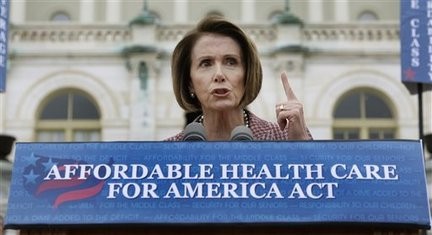Obama Promises Opportunities for America

affordable-health-care-nancy-pelosi-102908jpg-b86c46e6a7e7ca2b_large
March 10, 2014
It has been more than a month since President Obama vowed “…. to expand opportunity for more American families…”. I’m not sure how the President defines the word opportunity, but a report that the non-partisan Congressional Budget Office (CBO) released last month made it difficult to believe that any new opportunities will be coming from this administration. CBO reported that Obamacare will shrink the economy by the equivalent of 2.5 million full-time workers.
Obamacare requires employers with 50 or more full-time-equivalent employees to provide health coverage for all their full-time employees (full-time is defined as working 30 or more hours a week or 120 hours or more per month) or pay an annual penalty of $2,000 per full-time employee. If they do provide coverage but it’s not “affordable,” (“affordable” is defined as less than 9.5% of the employee’s family income) a $3,000 penalty is enforced for every employee who finds it “unaffordable”. Penalties are assessed on a monthly basis.
This means, if an employee is looking to pick up extra hours each week, say 35hours instead of 30, the employer will have to pay $400 for each of those five hours, on top of the employees regular wages. If the employer does allow that worker to increase his hours, the money for the penalty would have to come from somewhere. And there are really only three places where the money could come from: reduced profits, higher prices, or lower pay for workers.
If the company is in an industry that has very low profit margins, the employer cannot afford to reduce profits, and if he wants to stay competitive he certainly can’t raise his prices. So the money to pay for the penalty enforced by Obamacare will come out of the pockets of the employees in the form of lower wages.
Now, if you bring the argument of minimum wage into this, you get an even bigger mess. If minimum wage is increased there are still three places where the money could come from: reduced profits, higher prices, or reduced hours. We have already seen that the first two choices are not real options for companies. That means the only way employers can pay their workers higher wages is by cutting their hours, which is exactly what is taking place in the marketplace. Companies are making announcements that they will limit their employees to 25hours a week to afford the penalty.
There is actually another option for employers if minimum wage is increased and workers want more hours, and that is simply to start laying off people. According to the Bureau of Labor Statistics, 3.6 million people worked at or below the federal minimum wage. 25 percent of these workers are under 25 years old. This means that a large amount of workers that could be laid off by minimum wage increases would high schoolers and young adult. As someone who has had a job since the age of 12, I cannot say how valuable the experiences and the skills that I learned working through high school were.
During the presidential campaign of 1928, Herbert Hoover claimed that if he won the election there would be “a chicken in every pot and a car in every garage.” That promise meant nothing seven months later when the stock market crashed and America fell into the Great Depression. President Obama keeps making promises about the “opportunities” he is going to create, but after the release of this CBO report, it seems that his promise is on par with Hoover’s in 1928. And that does not bode well for America.











